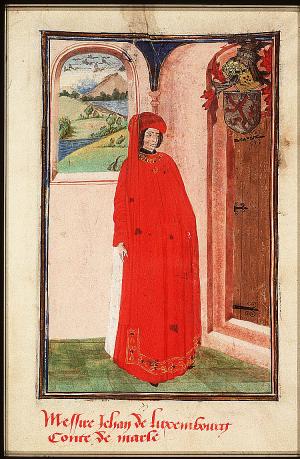Jean Albert De Schryver (born 7 March 1916, date of death unknown) was a Belgian boxer who competed in the 1936 Summer Olympics. In 1936 he was eliminated in the second round of the middleweight class after losing his fight to Henryk Chmielewski.
Schrijver means "writer" in Dutch. As a surname, it may refer to various people. See:

The Volunteer Combatant's Medal 1914–1918 was a Belgian wartime service medal established by royal decree on 17 June 1930 and awarded to Belgian citizens and foreign nationals who voluntarily enlisted for service in the Belgian Armed Forces during World War I.

The Christian Social Party was a major centre-right political party in Belgium which existed from 1945 until 1968.
The minister of justice of Belgium is responsible for the Federal Public Service Justice.

John of Luxembourg was Count of Marle and Count of Soissons between 1462 and 1476, Lord of Dunkirk, Gravelines and Bourbourg.

The Centenary of National Independence Commemorative Medal 1830-1930 was a Belgian commemorative medal established by royal decree on 20 July 1930 to commemorate the 100th anniversary of Belgian independence.

The Belgo-Congolese Round Table Conference was a meeting organized in two parts in 1960 in Brussels between on the one side representatives of the Congolese political class and chiefs and on the other side Belgian political and business leaders. The round table meetings led to the adoption of sixteen resolutions on the future of the Belgian Congo and its institutional reforms. With a broad consensus, the date for independence was set on June 30, 1960.
Francis Esdale Schryver, was an Australian soldier and swimmer. He competed for Australasia at the 1912 Summer Olympics in the men's 200 metre breaststroke and the men's 400 metre breaststroke. In doing so, he became the first Western Australian to represent Australia at an Olympic Games.
Gustave De Schryver was a Belgian cyclist. He competed in the Men's 4000m Team Pursuit and the Men's 50 km at the 1920 Summer Olympics.

August Edmond De Schryver was a Belgian politician. During the course of his political career, between 1935 and 1960, he held a number of ministerial portfolios within several successive governments including the Belgian government in exile during World War II. He was also President of the Christian Social Party between 1945 and 1949. As Minister of the Colonies until 1960, he presided over the independence of the Belgian Congo.

The Three Marys at the Tomb is a c. 1410–26 panel painting usually attributed to Hubert van Eyck, now in the Museum Boijmans Van Beuningen, Rotterdam. The painting was included at the seminal Exposition des primitifs flamands à Bruges in 1902.
Léon-Jean de Paepe (1610–1685), lord of Glabbeek, was an officeholder and statesman in the Spanish Netherlands. After serving on the Council of Brabant in Brussels and on the Supreme Council of Flanders in Madrid, De Paepe was appointed president of the Privy Council of the Habsburg Netherlands in 1674. He died on 8 August 1685.
Tine Schryvers is a former Belgian footballer. She played as a forward for Club YLA in Super League Vrouwenvoetbal and the Belgium women's national football team.
Guillaume Luc De Schryver is a Belgian footballer who plays for Deinze in the Challenger Pro League as a centre midfielder.
Antoine Philippe De Schryver (1924–2005) was a Belgian art historian and professor at the University of Ghent, where he lectured on History of Book Illumination. He was specialized in the field of illuminated manuscripts in the Southern Netherlands, 15th century painting, and artists at the Burgundian Court.
Terre de Suète also known as Terre de Sueth, was the name applied by the Franks to a region east of the Sea of Galilee, referring to its dark basalt soil. The core of the region was the fertile, corn-producing area of the Hauran and extended to the Golan Heights and beyond the river Yarmouk south to the Zarqa river, including Ajloun. The region was invaded by Tancred in 1100, and after intervention by Duqaq, the emir of Damascus, agreed to Frankish suzerainty. In the period 1105–1126, the Franks of Jerusalem made several unsuccessful efforts to wrest control of the region from Damascus.
Elizabeth Blodget Lord (1887–1974) was a founding partner of Lord & Schryver, the first female owned and operated landscape architecture firm in the Pacific Northwest from 1929 to 1969.
Edith Eleanor Schryver (1901–1984) was a founding partner of Lord & Schryver, the first female owned and operated landscape architecture firm in the Pacific Northwest from 1929 to 1969.

Frans Carl De Schryver is a Belgian chemist currently serving as Professor Emeritus in the Department of Chemistry of the KU Leuven. Pursuing his interests in polymer synthesis, time and space resolved chemistry, he founded the Laboratory for Photochemistry and Spectroscopy at the KU Leuven. He has co-authored over 650 papers in peer-reviewed journals.

Louis Marie de Schryver was a French painter celebrated for his vibrant and detailed depictions of Parisian life during the Belle Époque. He is best known for his renderings of flower markets, urban streetscapes, and portraits of fashionable women, his work encapsulates the elegance, charm, and vitality of late 19th and early 20th-century Paris. His meticulous technique and ability to portray light, texture, and movement made him one of the key chroniclers of this golden age in French history.